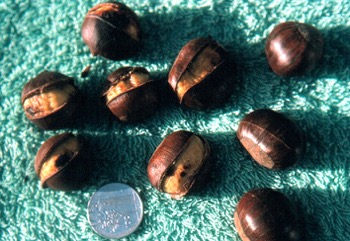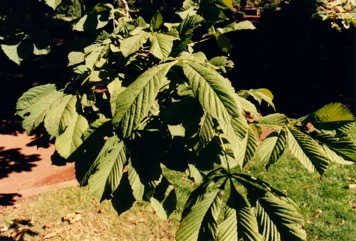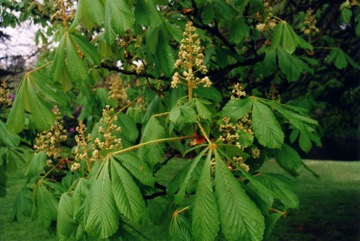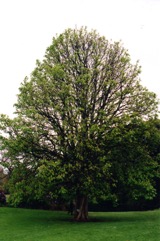European horse chestnut

It is a temperate plant. It requires rich sandy loam. It is drought and frost resistant. It needs a protected sunny position. It can grow on poorer soils and in exposed positions. Trees are very hardy when dormant. In Melbourne Botanical Gardens. It suits hardiness zones 6-9. At Anvers Chocolate factory. Arboretum Tasmania.
Also known as:
Buckeye, Common Horse-chestnut, Horse chestnut, Kastan, Segah, Spanish chestnut, Vadesztenye
Edible Portion
- Seeds, Poisonous
Where does European horse chestnut grow?
Found in: Albania, Asia, Australia, Balkans, Britain, Bulgaria, Canada, Central America, China, Czech Republic, Estonia, Europe, France, Germany, Greece, Hungary, India, Italy, Lithuania, Macedonia, Mexico, Netherlands, Northeastern India, North America, Portugal, Spain, Tasmania, Turkey, United States, Yugoslavia
Notes: The seed contains up to 40% water, 8 - 11% protein and 8 - 26% toxic saponins. Esculin is contained in the leaves and fruit. There are 15 Aesculus species. Also put in the family Hippocastanaceae.
Growing European horse chestnut
Cultivation: It is grown from seed. The seed need to be planted immediately after opening the nuts. Seed germinates quickly. Trees transplant fairly easily. Trees can be pruned heavily.
Edible Uses: The roasted seed is used as a coffee substitute. CAUTION: This plant contains saponins which although poisonous are not normally easily absorbed by the body. It is nevertheless probably not wise to eat large quantities. The seeds are eaten cooked. Before eating they are slowly roasted then often crushed and washed for 2-5 days in running water. They are then dried and ground into a powder.
Production: A fast growing tree. The tree comes into bearing within 20 years from seed. Trees live for 100 years.
Nutrition Info
per 100g edible portion| Edible Part | Energy (kcal) | Protein (g) | Iron (mg) | Vitamin A (ug) | Vitamin c (mg) | Zinc (mg) | % Water |
|---|---|---|---|---|---|---|---|
| Seeds | - | - | - | - | - | - |
European horse chestnut Photos




References
Ambasta S.P. (Ed.), 2000, The Useful Plants of India. CSIR India. p 18
Bircher, A. G. & Bircher, W. H., 2000, Encyclopedia of Fruit Trees and Edible Flowering Plants in Egypt and the Subtropics. AUC Press. p 11
Bodkin, F., 1991, Encyclopedia Botanica. Cornstalk publishing, p 54
Bremness, L., 1994, Herbs. Collins Eyewitness Handbooks. Harper Collins. p 34
Brickell, C. (Ed.), 1999, The Royal Horticultural Society A-Z Encyclopedia of Garden Plants. Convent Garden Books. p 84
Brouk, B., 1975, Plants Consumed by Man. Academic Press, London. p 214
Brown, D., 2002, The Royal Horticultural Society encyclopedia of Herbs and their uses. DK Books. p 104
Chen, B. & Qiu, Z., Consumer's Attitudes towards Edible Wild Plants, Ishikawa Prefecture, Japan. p 22 www.hindawi.com/journals/ijfr/aip/872413.pdf
Coombes, A.J., 2000, Trees. Dorling Kindersley Handbooks. p 179
Cundall, P., (ed.), 2004, Gardening Australia: flora: the gardener's bible. ABC Books. p 107
Denes, A., et al, 2012, Wild plants used for food by Hungarian ethnic groups living inthe Carpathian Basin. Acta Societatis Botanicorum Poloniae 81 (4): 381-396
Etherington, K., & Imwold, D., (Eds), 2001, Botanica's Trees & Shrubs. The illustrated A-Z of over 8500 trees and shrubs. Random House, Australia. p 79
Farrar, J.L., 1995, Trees of the Northern United States and Canada. Iowa State University press/Ames p 158
Guite, C., 2016, A study of wild edible plants associated with the Paite tribe of Manipur, India, International Journal of Current Research. Vol. 8, Issue, 11, pp. 40927-40932
Harris, B.C., 1975, Eat the Weeds. Barre. p 93
Harris, E & J., 1983, Field Guide to the Trees and Shrubs of Britain. Reader's Digest. p 158
Heywood, V.H., Brummitt, R.K., Culham, A., and Seberg, O., 2007, Flowering Plant Families of the World. Royal Botanical Gardens, Kew. p 294
Huxley, A. (Ed.), 1977, The Encyclopedia of the Plant Kingdom. Chartweil Books. p 138
Joyce, D., 1998, The Garden Plant Selector. Ryland, Peters and Small. p 106
Kalle, R. & Soukand, R., 2012, Historical ethnobotanical review of wild edible plants of Estonia (1770s-1960s) Acta Societatis Botanicorum Poloniae 81(4):271-281
Little, E.L., 1980, National Audubon Society Field Guide to North American Trees. Alfred A. Knopf. p 585
Lord, E.E., & Willis, J.H., 1999, Shrubs and Trees for Australian gardens. Lothian. p 46
Menninger, E.A., 1977, Edible Nuts of the World. Horticultural Books. Florida p 113
Morley, B. & Everard, B., 1970, Wild Flowers of the World. Ebury press. Plate 19
Plants for a Future database, The Field, Penpol, Lostwithiel, Cornwall, PL22 0NG, UK. http://www.scs.leeds.ac.uk/pfaf/
Ryan, S., 2008, Dicksonia. Rare Plants Manual. Hyland House. p 6
Sfikas, G., 1984, Trees and shrubs of Greece. Efstathiadis Group. Athens. p 118
Simkova, K. et al, 2014, Ethnobotanical review of wild edible plants used in the Czech Republic. Journal of Applied Botany and Food Quality 88, 49-67
Sp. pl. 1:344. 1753
Vermeulen, N, 1998, The Complete Encyclopedia of Herbs. Rebo Publishers. p 26
Wickens, G.E., 1995, Edible Nuts. FAO Non-wood forest products. FAO, Rome. p 132
Young, J., (Ed.), 2001, Botanica's Pocket Trees and Shrubs. Random House. p 72